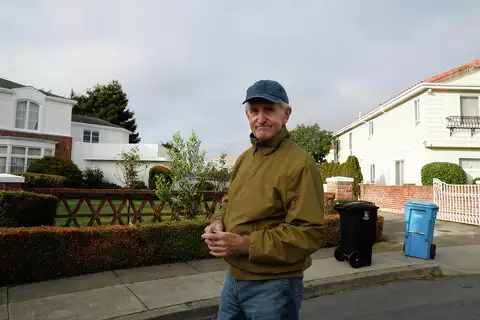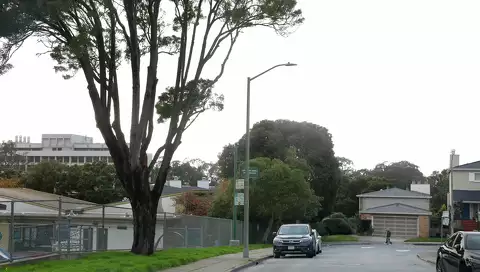 Lakeside resident Jim Hurlihy opposes part of the city’s rezoning plan in the San Francisco neighborhood. Lea Suzuki/The Chronicle
Lakeside resident Jim Hurlihy opposes part of the city’s rezoning plan in the San Francisco neighborhood. Lea Suzuki/The Chronicle
https://www.sfchronicle.com/sf/article/rezoning-backlash-lakeside-18621676.php
By J.K. Dineen Jan 27, 2024
For nearly two years, San Francisco officials have been pitching a plan to add thousands of new housing units by allowing taller apartment buildings on transit corridors: wide boulevards such as Geary, Irving and Judah, where streetcars and major bus lines ply busy shopping strips.
So when Lakeside residents saw the proposed rezoning map, they were baffled to discover that nearly half of their neighborhood — an enclave of narrow one-way streets and single-family homes with lemon trees and white picket fences across 19th Avenue from Stonestown Galleria — was targeted for eight-story buildings.
Resident Barb Debaun, who attended a recent community meeting on the proposal, said she was shocked when she looked at the plan’s fine print.
“We were blindsided,” she said. “It was presented as if it were a done deal. What they are planning would have a destructive impact on the quality of life in this neighborhood.”
For the past two years, the Planning Department vision for upzoning transit corridors on the west side, and other neighborhoods, has been hashed out in commission meetings and at neighborhood presentations. But while revamping a city’s zoning mostly involves drawing lines on a map, the reality of those changes — how they might impact the look and feel of a neighborhood like Lakeside — is just starting to sink in.
Even Lakeside residents who agree with the department’s goals of “expanding housing affordability and availability” through increased density say they were not prepared for the real-world implications of a rezoning that would allow an 85-foot building to sprout where a two-story home currently sits.
In Lakeside, the proposed upzoning is being driven by the fact that the neighborhood backs up onto 19th Avenue, which, in addition to being State Highway 1, is served by the M-Oceanview line.
On paper the 147 properties along the west side of Stonecrest and Denslowe drives look like they are on 19th Avenue. But, in reality, none of the homes has ingress and egress on 19th Avenue. While the rear yards back up onto 19th, the houses face narrow one-way streets. In addition, 109 homes that border Junipero Serra Boulevard will be upzoned from 26 feet to 65 feet.
 The corner of Denslowe Avenue would be affected by the plan to rezone San Francisco’s Lakeside neighborhood, with multistory buildings from the Parkmerced neighborhood behind it. Lea Suzuki/The Chronicle
The corner of Denslowe Avenue would be affected by the plan to rezone San Francisco’s Lakeside neighborhood, with multistory buildings from the Parkmerced neighborhood behind it. Lea Suzuki/The Chronicle
“They just took a red pen and everything that touched 19th Avenue went from 28 to 85 feet,” said Katherine Petrin, an architectural historian and preservation planner who lives in Lakeside.
In total, the proposed rezoning would increase height limits of 256 parcels — 43% of all the homes in Lakeside, according to Petrin.
Lakeside was developed in the late 1930s and early 1940s by Henry Stoneson and his brothers. Like West Portal and St. Francis Woods, it was a streetcar suburb targeting the “San Francisco executive or professional man,” according to an article in Western Neighborhoods Project, which explores the history of San Francisco’s west side. The article quotes a 1936 issue of California Homes, in which Lakeside is described as a place “close to your executive offices both in the matter of distance and the matter of time due to the Twin Peaks Tunnel.” It touts Lakeside’s white picket fences, which “enhance the exclusive, old fashioned charm of beautifully designed homes.”
In addition to the 590 residential parcels, the neighborhood has Lakeside Village, a cozy three-block retail strip along Ocean Avenue between Junipero Serra and 19th Avenue. The village has restaurants such as Lucho’s, Ocean Thai and Ofena, as well as an array of nail salons, yoga studios, hairdressers and eyeglass stores.
But there are vacancies as well, and even residents who oppose the rezoning say the village could benefit from more housing density. Walgreens shut down in 2021, and the family Italian spot Villa d’Este shuttered in 2022. Residents say there are several opportunities for multifamily housing, including the Walgreens block and the Chicago Title building at 301 Junipero Serra.
“There are sites that would be great for upzoning in our neighborhood, but they have to be thoughtfully chosen,” Petrin said.
Jim Hurlihy, who has lived in Lakeside since 1987, agrees that there are some sites where more density is appropriate, but he called the current rezoning plan “sloppy, one-size fits all.” He argued that the rezoning is being fast-tracked because of pressure from California Department of Housing and Community Development, which has the power to withhold funding if the city fails to meet state-mandated goal of planning for 82,000 units by 2031.
Lakeside resident Jim Hurlihy walks along 19th Avenue near the backs of homes adjacent to traffic. Hurlihy opposes part of the plan to rezone certain streets in the San Francisco neighborhood to allow some buildings to be 85 feet tall. Lea Suzuki/The Chronicle
“It’s a knee-jerk reaction to what is going on in Sacramento, a flawed process the consequences of which we are going to have to live with for decades,” he said. “How many other neighborhoods haven’t read the fine print and will be stuck with this kind of stealth upzoning?”
While the rezoning may face opposition from longtime residents, planners have made it clear that sweeping change is needed to “increase housing affordability for low- and middle-income households, and help advance racial and social equity.” The department’s website on the rezoning makes it clear that part of the motivation is to get rid of zoning that has been used to “reinforce patterns of economic and racial segregation” and exclude low- and middle-class families.
Planning Department Chief of Staff Dan Sider stressed that the rezoning plan will “continue to evolve” as it goes through the approval process at the Planning Commission and the Board of Supervisors.
“For Lakeside and every other neighborhood, the rezoning process is iterative,” he said.
“The current proposal is focused on transit routes, commercial streets and major roadways. We recognize that Lakeside’s established pattern of single-family homes adjacent to significant thoroughfares is unusual. Without question, this will be part of the conversation as we move ahead.”
Supervisor Myrna Melgar, who represents Lakeside, said she was surprised that so many parcels in Lakeside were upzoned.
“It’s like someone took a highlighter and went ‘whoosh’ along 19th Avenue,” she said. “Rezoning single family homes to 85 feet on a narrow, one-way street is not appropriate, but you wouldn’t know that unless you walked the neighborhood.”
Melgar, who heads up the board’s land use and transportation committee, said the rezoning “is going to be a long process.” While she said the rezoning has to create capacity to meet the state-mandated requirement of planning for 82,000 units over the next eight years, getting to that point will require “nuanced, complicated” discussions.
“I won’t schedule it at committee until it’s ready,” she said.
But not everyone thinks that single-family streets in Lakeside should be left out of the rezoning. Housing Action Committee Executive Corey Smith said the fact that Lakeside is a short walk from multiple Muni lines — as well as several grocery stores, San Francisco State and other services — makes it a great candidate for density.
Stonecrest Drive would be affected by part of the plan to rezone certain streets in the Lakeside neighborhood. Lea Suzuki/The Chronicle
Brookfield, the investment company that owns Stonestown Galleria, located directly across 19th Avenue from Lakeside, is seeking approvals for 2,900 housing units.
“Call me crazy, but if you are within a quarter-mile of a major transit station, that is a great place to put apartment buildings and affordable housing,” Smith said. “I know some people are going to be unhappy, but this has been a multiyear process. Now people are trying to fight it?”
Smith said he is afraid that neighbors in all the areas slated for rezoning will attempt to carve out exemptions in their backyards. “I think it is going to go through the political wringer.”
By J.K. Dineen
J.K. Dineen covers housing and real estate development. He joined The Chronicle in 2014 covering San Francisco land use politics for the City Hall team. He has since expanded his focus to explore housing and development issues throughout Northern California. He is the author of two books: “Here Tomorrow” (Heyday, 2013) and “High Spirits” (Heyday, 2015).


 The corner of Denslowe Avenue would be affected by the plan to rezone San Francisco’s Lakeside neighborhood, with multistory buildings from the Parkmerced neighborhood behind it. Lea Suzuki/The Chronicle
The corner of Denslowe Avenue would be affected by the plan to rezone San Francisco’s Lakeside neighborhood, with multistory buildings from the Parkmerced neighborhood behind it. Lea Suzuki/The Chronicle
